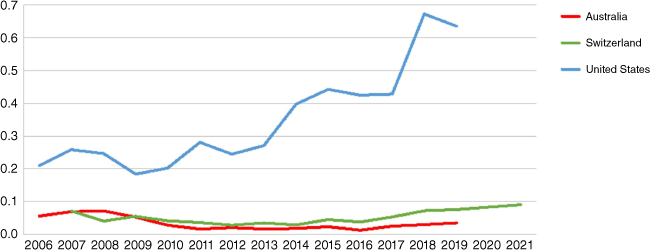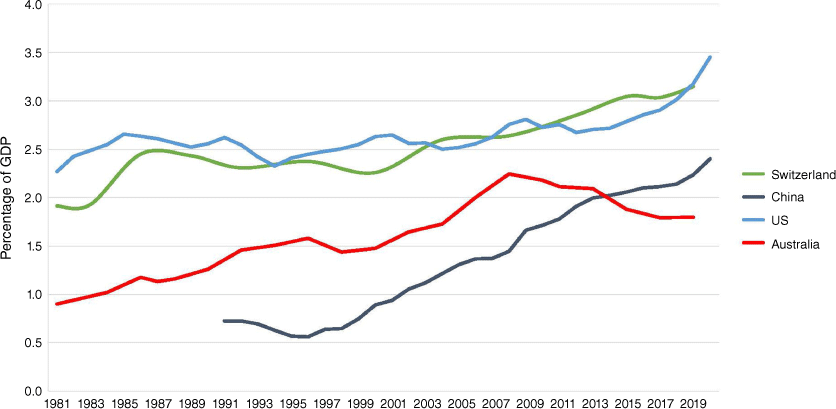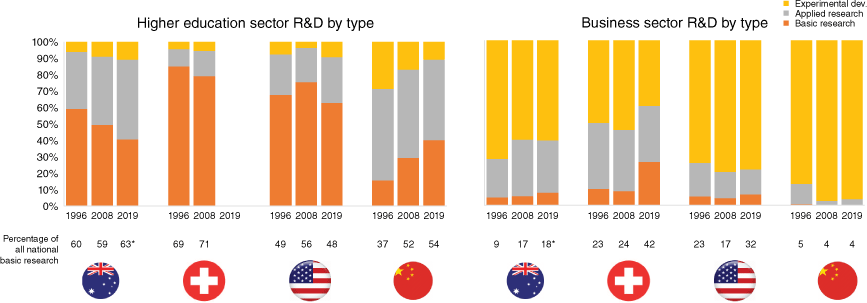Restoring Australia’s long-term innovation requires investment in basic research
Rosemary S. Harrison A , Ross T. Barnard B * and Lisette Pregelj BA TCR2 Therapeutics, 100 Binney Street, Cambridge, MA 02142, USA.
B School of Chemistry and Molecular Biosciences, The University of Queensland, St Lucia, Qld 4072, Australia.

Dr Rosemary Harrison is a Biotechnology executive with nearly 20 years of global experience working on pharmaceutical corporate strategy, portfolio management and business development. She is currently Chief Business and Strategy Officer at TCR2 Therapeutics (NASDAQ: TCRR) in Boston, USA, responsible for driving a range of activities including strategy, operational planning, corporate partnerships and long-term growth opportunities. Dr Harrison holds a Bachelor of Biotechnology in Drug Design and Development (Hons, UQ Medal) and a PhD from The University of Queensland. |

Emeritus Professor Ross Barnard, FASM, was director of the biotechnology program at the University of Queensland from 2000 to 2019. Prior to that he was at Panbio Ltd (as program leader for nucleic acid diagnostics development) and the Cooperative Research Centre for Diagnostic Technologies. He has worked on diagnostics development for a variety of infectious agents. In 2005, he undertook a sabbatical at the Australian Animal Health Laboratory in Geelong, Vic., Australia (now the Australian Centre for Disease Preparedness), during which time he collaborated on the development of a broad-spectrum, RT-PCR-based Influenza A diagnostic. He was a NHMRC C. J. Martin Fellow at the University of Queensland and the University of California, Santa Cruz. |

Dr Lisette Pregelj is a Lecturer in Biotechnology at The University of Queensland (UQ). Her research and teaching focuses on commercialisation of biotechnology and pharmaceutical innovations, specifically precision medicines and medical devices and the effect of regulation and innovation capabilities on their speed from discovery through to market. She previously held Postdoctoral Research Fellowships with UQ’s Business School and Australian Institute of Business and Economics. |
Microbiology Australia 44(1) 57-61 https://doi.org/10.1071/MA23014
Submitted: 16 January 2023 Accepted: 16 February 2023 Published: 2 March 2023
© 2023 The Author(s) (or their employer(s)). Published by CSIRO Publishing on behalf of the ASM. This is an open access article distributed under the Creative Commons Attribution-NonCommercial-NoDerivatives 4.0 International License (CC BY-NC-ND)
Abstract
It is well established that basic research underpins long-term innovation outputs such as transformative drugs and medical devices. However, Australia may be hobbling its long-term innovation capabilities by decreasing investment in basic research. Although there has been recent growth in our local venture capital and biopharmaceutical business sectors (that typically fund applied research and experimental development), both are comparatively undersized. Initiatives are needed to ensure long-term commitment to basic research at globally competitive levels and to ensure that long-term innovation capabilities are supported.
Science enables new discoveries; it is the fuel for transformed industries … [but] … have we done all that we can to ensure that great Australian science, put to new industrial uses, is set up not just to survive but thrive in this country? [Ed Husic MP, National Press Club, November 2022].
Research and development (R&D) in the medical, biotechnology, and pharmaceutical sectors (‘biomed’ sector for brevity), is unique among industries. Distinguished by very high costs, long product development times and high risks, biomed has one of the highest R&D intensities of any industry.1 For example, a novel oncology treatment typically requires 10–15 years and costs US$2.7 billion to advance from basic research to licensure, yet with only a 3.4% chance of successfully launching on the market.2 Given the R&D intensity, multiple stakeholders are often required to finance and deliver biomed innovations as they progress through their technology readiness levels (TRLs).3 In Australian biomed industries, as well as in many other jurisdictions globally, governments typically finance basic, and some applied research, from TRLs 1–3 through higher education investment in research and development (HERD), venture capital and private equity, whereas business typically finances later-stage applied R&D activities, such as preclinical and clinical trials from TRLs 4–9, through business investment in research and development (BERD). However, without well-developed venture capital funds, or a culture of private equity and business investment in research, governments are often required to invest in applied R&D activities with the objective of ensuring that basic research technologies advance to market.
Over the last two decades, significant effort has been made in Australia to develop and attract biomed research funding, encourage both private and business investment, and progress basic research technologies through their TRLs. The Commonwealth Government funds basic research primarily through the National Health and Medical Research Council (NHMRC), the Australian Research Council (ARC) and the newly established (2015) Medical Research Future Fund (MRFF). Both the ARC and NHMRC funds have schemes in place to encourage business investment, translation and advancement of basic research towards later TRLs (notably the ARC Linkage scheme and NHMRC Partnership Projects scheme). The MRFF strategically focuses on translation of research outcomes into policy and practice, as well as commercialisation of new technologies.4 The Australian venture capital sector has been growing in both absolute size of assets under management and as a percentage of gross domestic product (GDP) (see Fig. 1); in 2013, venture capital investment represented 0.016% of GDP and increased 1.8 fold in the 5-year period to 2018.5 But, has the increase in funding across all TRLs been enough to support Australia’s biomed sectors and encourage long-term innovation success?

|
Australia’s innovation output
The recent 2022 Global Innovation Index (GII) ranked Australia 25th among 132 countries for its innovation capabilities.7 Our ranking has been steadily declining over the past 5 years, down from 23rd in 2020, 22nd in 2019 and 20th in 2018. More concerning is that we rank even lower for our innovation outputs, with no sign of improvement over the last 3 years (31st in 2020, 33rd in 2021 and 32nd in 2022).7 Our innovation output score and corresponding global rank has been consistently described as a weakness.7 Innovation output measures include knowledge and technology outputs such as intellectual property (IP), financial returns on that IP, numbers of scientific journal articles and their H-indices, and numbers of new businesses, to name just a few; widely accepted as important measures of industry growth and returns to investment in R&D.6 Further, Australia’s innovation productivity score, that is our innovation output score divided by our input score, is less than 60% and has been steadily declining since 2013. This suggests we are not effective at ‘translating costly [basic research] innovation investments into quality output. Australia produces fewer innovation outputs relative to its level of innovation investment’.7 Leading biomed innovation economies such as the United States of America and Switzerland, and emerging economies such as China, are far more effective at translating innovation investments into outputs; China and Switzerland’s innovation productivity scores are above 90% and have been consistently so over the last 5 years, and, although the USA’s score is just below 80%, its overall innovation index has consistently ranked in the top five economies.7 Given our strong government investment in research and growing venture capital sector, why is Australia performing so poorly in comparison to other leading economies?
Australia’s innovation input
The answer may lie in the quantity and type of investment into our innovation process across TRLs. In terms of later TRLs, although Australia’s venture capital investments have grown, the rate has been lower than the other leading biomed innovation economies mentioned above: Switzerland’s venture capital investment increased 2.3 fold and the US’s venture capital investment increased 2.6 fold (see Fig. 1).6 In terms of earlier TRLs, Australia has also been underinvesting in R&D relative to GDP compared to the US, Switzerland and China. From the 1980s until 2008, Australia was increasing R&D investment as a percentage of GDP at a similar rate to other large economies (see Fig. 2).6 However, for the most recent 15 years, Australia has decreased R&D investment as a percentage of GDP, while other global economies have continued to increase their R&D investment over the same period.

|
In terms of type of R&D, we observe that the higher education execution of basic research in Australia has been steadily declining relative to applied research and experimental development (see Fig. 3, left).6 Notably, Australia’s higher education sector has decreased execution of basic research by 18% since 1996 while prioritising applied research (+14%) and experimental development (+5%). In 1996, nearly 60% of Australia’s HERD was executing basic research, but in 2019 basic research only accounted for 40% of total HERD. This has not been the case for the US or China, both of which have increased their proportions of HERD in basic research. Indeed, with the expansion of the Chinese economy, China’s basic research execution as a proportion of total HERD has increased from 15 to 40% over the last 15 years (Fig. 3, left).6 Although Switzerland decreased the proportion of HERD execution of basic research between 1996 and 2008, it still maintained an overall relative execution of basic research at ~70% of HERD (the highest of the three comparison economies). Further, execution of basic research by Switzerland’s business sector (BERD), relative to applied and experimental development, increased to 26% in 2019, up from 10% in 1996 (see Fig. 3, right).6

|
The importance of basic research
After World War II, President Franklin D. Roosevelt commissioned a report to distill the lessons learnt from wartime to inform investment in the future US economy. The report made the case for Government support of basic research, defining basic research as that which is ‘essential for combatting disease, ensuring national security, and increasing the standard of living, including supporting new industries and jobs … [that] results in general knowledge and an understanding of nature and its law’.8 Five years later, US Congress created the National Science Foundation, which, in collaboration with the National Institutes of Health, underpins the USA’s investment in basic research. With a focus on pharmaceutical drug development, Spector et al.9 further highlighted that the most transformative and successful medicines exist today because of fundamental, basic research that was carried out decades before their eventual launch on the market. Without this basic research, conducted without an explicit, short-term goal of drug discovery, medicines such as the ACE inhibitor captopril, cancer treatment imatinib, or cardiovascular treatment lovastatin would not have existed to benefit patients, nor have contributed to the subsequent creation of trillion-dollar markets.
Improving Australia’s biopharmaceutical sector
In view of the clear importance of basic research investment for longer term innovation outputs, juxtaposed with declining investment in total R&D and basic research funding, a relatively undersized venture capital industry, and comparatively limited BERD, how can Australia’s medical, biotechnology and pharmaceutical sectors advance discoveries through their TRLs, ensure efficient innovation outputs and remain globally competitive?
One solution is to increase our investment into basic research in the higher education sector thereby reversing the decline in investment in basic research relative to applied research. In Australia, however, ARC and NHMRC funding has not substantially increased over the past decade, whereas the MRFF, whose activities arguably fall outside the basic research TRLs, grew to A$20 billion in July 2020.4,10,11 Indeed none of the seven guiding principles of the MRFF mention acquisition of greater knowledge or improving fundamental understandings of phenomena; in the words of Vannevar Bush, supporting research ‘that results in general knowledge and an understanding of nature and its law’.8 Although the guiding principles focus on very important outcomes, a focus on funding basic research for the sake of fundamental knowledge is the crucial foundation. It is vital so that our innovation pipeline is well supported at its origins.
Another solution could be to increase Australia’s total R&D investment to globally competitive levels, as was the case prior to 2008. The authors welcome the announcement of the A$15 billion National Reconstruction Fund intended to strengthen Australia’s medical science, among other areas. Government support for innovation is absolutely critical, but investment from other stakeholders is also critical. For example, leading innovative countries have either been able to attract foreign investment into their economies or have a healthy and growing local business, venture capital and private equity sector responsible for funding primarily later-stage applied biopharmaceutical R&D. Compared to other countries, foreign direct investment inflow to Australia has recently decreased from 3–5% of GDP in 2009–19 to 1–2% in 2020–21, and this foreign investment is highly concentrated in mining and quarrying (35% of all FDI inflow positions in 2019), financial and insurance (11%) and real estate (11%), with no data available for the biopharmaceutical sector.5 In comparison, the US’s pharmaceutical sector is one of their largest beneficiaries of foreign direct investment representing 12% of positions.6
Australia is also under-represented in venture capital, which is a critical enabler of transitioning basic research into more applied and experimental development efforts. Venture capital investment correlates very strongly with success of countries in developing emerging sectors like therapeutic stem cell research.12 According to the Preqin database,13 the global venture industry has ~A$1.7 trillion in assets under management (as of March 2021),13 where the Australian venture capital sector represents ~A$12 billion (as of June 2021)5 or 0.7%. Although the total number of both venture deals and deal size in Australia has increased over the last decade, investments were predominantly in IT, consumer discretionary and financial services start-ups, rather than the healthcare sector.5
Based on the clear evidence of the crucial dependence of biomedical breakthroughs on fundamental research that precedes them by decades, the National Reconstruction Fund’s Reference Group should commit to Australia’s basic research capability and contribute to restoring Australia’s investment to long-term innovation. Without a commitment to funding basic research at globally competitive levels, Australia will see its innovation ecosystem and bench of well-trained scientists further diminished over the next decade. We suggest that the National Reconstruction Fund’s Reference Group should develop mechanisms to encourage venture capital and potentially foreign investment into Australia’s basic research in higher education settings, our immense talent pool, as well as applied and experimental development research. These mechanisms could include new or more effective incentives for international business investment, repatriating and importing talent with international experience into the Australian ecosystem (often bringing capital with them), and strengthening our links into global life science networks. Although more needs to be done to understand the current barriers to global business investment into Australian R&D, the recent success stories such as the Inflazome acquisition by Roche, ResApp acquisition by Pfizer and AstraZeneca’s deal with Starpharma demonstrate that some foreign investors see the opportunities and appreciate the outcomes of Australian basic research projects that began in higher education settings. The COVID-19 pandemic reminded us of the importance of investment in basic discovery research, particularly in the field of microbiology. Without the foresight of the Coalition for Epidemic Preparedness Innovations (CEPI) in investing in the basic research performed by companies such as Moderna, it is doubtful whether a novel mRNA covid vaccine candidate would have been in clinical trials within 2 months of the outbreak, a timeframe that was substantially faster than for novel vaccine candidates during other epidemics such as the 2009 H1N1 swine flu or 2014 Ebola outbreaks.14
Data availability
The data that support this study are primarily publicly available in the sources cited in the references section, or were obtained from Prequin by subscription. Data will be shared upon reasonable request to the corresponding author with permission from Prequin.
Conflicts of interest
The authors declare that they have no conflicts of interest.
Declaration of funding
This research did not receive any specific funding.
References
[1] Grassano N et al. (2020) The 2020 EU industrial R&D investment scoreboard. Publications Office of the European Union.| Crossref |
[2] Wouters, OJ et al. (2020) Estimated research and development investment needed to bring a new medicine to market, 2009–2018. JAMA 323, 844–853.
| Estimated research and development investment needed to bring a new medicine to market, 2009–2018.Crossref | GoogleScholarGoogle Scholar |
[3] Kampers, LFC et al. (2021) From innovation to application: bridging the valley of death in industrial biotechnology. Trends Biotechnol 39, 1240–1242.
| From innovation to application: bridging the valley of death in industrial biotechnology.Crossref | GoogleScholarGoogle Scholar |
[4] Australian Government Department of Health and Aged Care (2022) About the MRFF. https://www.health.gov.au/initiatives-and-programs/medical-research-future-fund/about-the-mrff (accessed 25 November 2022)
[5] Australian Investment Council (2022) Australian private capital market overview: a Preqin and Australian Investment Council yearbook 2022. https://aic.co/common/Uploaded% 20files/Yearbooks/Australian-Private-Capital-Market-Overview-A-Preqin-and-Australian-Investment-Council-Yearbook-2022.pdf (accessed 7 November 2022)
[6] Organisation for Economic Co-operation and Development (2021) Science, technology and patents. OECD. https://www.oecd.org/statistics/data-collection/sciencetechnologyandpatents.htm
[7] World Intellectual Property Organization (2022) Global Innovation Index 2022: what is the future of innovation-driven growth? WIPO, Geneva, Switzerland. https://www.globalinnovationindex.org/home (accessed 7 November 2022)
[8] Bush V (1945) Science. The Endless Frontier. National Science Foundation. https://www.nsf.gov/about/history/EndlessFrontier_w.pdf (accessed 7 November 2022)
[9] Spector, JM et al. (2018) Fundamental science behind today’s important medicines. Sci Transl Med 10, eaaq1787.
| Fundamental science behind today’s important medicines.Crossref | GoogleScholarGoogle Scholar |
[10] Australian Research Council (2022) NCGP trends: funding overview. https://www.arc.gov.au/funding-research/funding-outcome/grants-dataset/trend-visualisation/ncgp-trends-funding-overview (accessed 2 November 2022)
[11] National Health and Medical Research Council (2022) Research funding statistics and data. https://www.nhmrc.gov.au/funding/data-research/research-funding-statistics-and-data (accessed 12 February 2023)
[12] Alobrah HMH (2016) The association between national innovation systems and therapeutic stem cell companies. PhD thesis, The University of Queensland. https://espace.library.uq.edu.au/view/UQ:594734
[13] Preqin (2022) 2022 Preqin Global Venture Capital Report. https://www.preqin.com/insights/global-reports/2022-preqin-global-venture-capital-report
[14] Pregelj, L et al. (2020) Working hard or hardly working? Regulatory bottlenecks in developing a COVID-19 vaccine. Trends Biotechnol 38, 943–947.
| Working hard or hardly working? Regulatory bottlenecks in developing a COVID-19 vaccine.Crossref | GoogleScholarGoogle Scholar |


